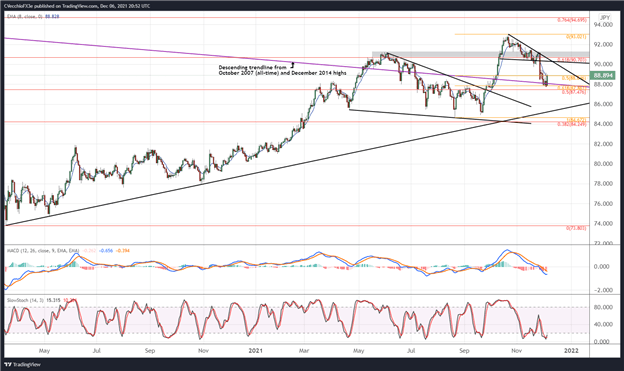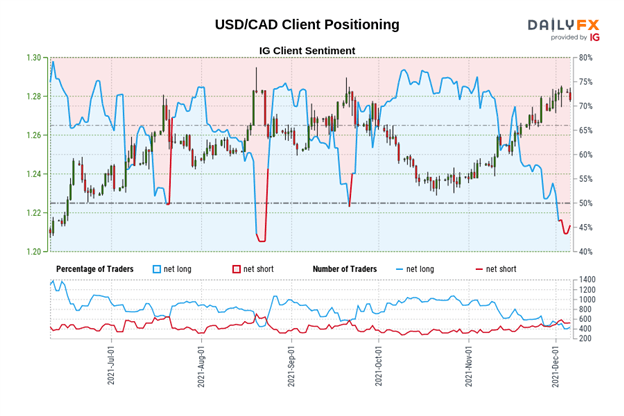Canadian Dollar Outlook:
- There are early technical indications that the Canadian Dollar sell-off has been exhausted.
- Rebounding oil prices and a Bank of Canada that is expected to be more hawkish this week are helping shift the fundamental narrative.
- According to the IG Client Sentiment Index, USD/CAD rates have a mixed bias in the near-term.



Technicals Point to CAD Turn
There are early indications that the Canadian Dollar sell-off at the end of November and early-December may have exhausted itself as trading moves towards the second week of the month. A rebound in crude oil prices is providing a release valve for the beleaguered Loonie, while speculation ahead of the final Bank of Canada rate decision of 2021 is duly giving traders a reason to stop selling. Technical studies suggest that the worst may be over for the Canadian Dollar in the near-term – never mind seasonal tendencies that point to a stronger Loonie in December.
CAD/JPY Rate Technical Analysis: Daily Chart (April 2020 to December 2021) (Chart 1)

CAD/JPY rates fell back to the descending trendline from the October 2007 (all-time high) and December 2014 highs last week but have already treated former multi-decade resistance as support. Support likewise appeared at the 61.8% Fibonacci retracement of the August low/October range near 87.86.
The daily candlestick is shaping into a bullish piercing candle, helping provoke a close above the daily 8-EMA for the first time since November 25. CAD/JPY rates are currently residing above their daily 5- and 8-EMAs, but remain below their daily 13- and 21-EMAs. Daily MACD’s descent below its signal line is starting to abate, while daily Slow Stochastics have started to perk up out of oversold territory. If there were a time and a place for CAD/JPY rates to find a bottom – this would be it.
USD/CAD Rate Technical Analysis: Daily Chart (December 2020 to December 2021) (Chart 2)

USD/CAD rates marched relentlessly higher in November and the trend appeared to continue through the early days of December. However, today’s losses by the pair have wiped out the gains accumulated last week, and moreover, are seeing USD/CAD rates drop below the descending trendline from the August and September swing highs, resistance of a symmetrical triangle that formed started in June. With the pair looking to close below its daily 8-EMA for the first time since November 1, there is a reasonable basis of belief that USD/CAD rates may have topped out for December – particularly if oil prices continue their rebound.

IG Client Sentiment Index: USD/CAD Rate Forecast (December 6, 2021) (Chart 3)

USD/CAD: Retail trader data shows 48.31% of traders are net-long with the ratio of traders short to long at 1.07 to 1. The number of traders net-long is 29.15% higher than yesterday and 2.84% lower from last week, while the number of traders net-short is 7.00% higher than yesterday and 8.70% higher from last week.
We typically take a contrarian view to crowd sentiment, and the fact traders are net-short suggests USD/CAD prices may continue to rise.
Positioning is less net-short than yesterday but more net-short from last week. The combination of current sentiment and recent changes gives us a further mixed USD/CAD trading bias.
--- Written by Christopher Vecchio, CFA, Senior Strategist







